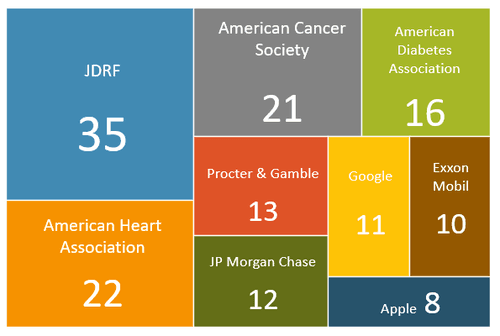
A RELATIVE COMPARISON OF THE SIZE OF THE BOARD OF DIRECTORS AT NON-PROFIT AND FOR-PROFIT ORGANIZATIONS
The Board of Directors has more influence on the performance and direction of an organization than anybody else. This is especially true for T1D non-profits, where the board is responsible for establishing the organization mission and values, setting the strategic direction, allocating funds, and most importantly exercising accountability to donors.
The board members at the ADA and JDRF have a fiduciary duty to fulfill the priorities of donors and shoulder the ultimate responsibility for keeping the organization on track. This is the group of people who are ultimately responsible for current research grant spending levels.
Little has changed in the five years the JDCA has been tracking the Board of Directors at the ADA and JDRF. Performance accountability of board members remains unclear for both organizations and public access to these individuals is extremely limited.
The ADA board is currently comprised of 16 individuals. Although still larger than many for-profit companies, the ADA's board is relatively in-line with non-profit board size norms. Additionally, every person on the board has a post-graduate degree and many hold medical degrees.
In comparison, JDRF's board is disproportionately large at 35 members. The board is composed mainly of wealthy individual donors who are selected from an internal population as opposed to a broad base of donors. It is also important to note that JDRF has never made a public comment addressing the size of the board, or how board members are chosen.
The JDCA offers six key recommendations about how to improve the performance of the boards, as we have done in the past. These recommendations are informed by best practices from the corporate world but acknowledge the unique circumstances of the non-profit. The recommendations are as follows:
- Hold board members externally accountable. Non-profit board members can only be appointed or removed by fellow board members, which consolidates power in an insulated bubble. Board member election by a broad base of donors would create accountability and ensure alignment with the donor base.
- Decrease the number of members on the non-profit boards. As shown in the opening chart, JDRF has 35 directors and the ADA has 16. In contrast, effective boards in many high-performing organizations have between 8 and 14 members— large enough to bring a range of skills and experience to the table but small enough to maintain a meaningful and fully engaged discussion.
- Deploy resources in line with donor priorities. In a 2017 JDCA survey asking donors how contributions raised at T1D fundraising events should be utilized, 96 percent of walkers surveyed said that they want the majority of funds raised at walks to be used for cure research. 72 percent of walkers surveyed said 100 percent of the money raised at fundraising walks should be used for cure research. However, in the same year only 38 percent of JDRF’s, and only 24 percent of the ADA’s annual income was spent on research. Without regular donor surveys and a continued dialogue in which donor sentiment is gauged, the ADA and JDRF will continue to be misaligned with the goals and wishes of their donors.
- Consider a "say on pay" executive compensation structure. A "say on pay" model or initiative would allow donors to vote on specific aspects of executive compensation such as pay structure, base pay, and bonus amounts. The JDCA believes a "say on pay" model could deliver T1D non-profit donors many of the same benefits it provides for-profit company shareholders, such as increased transparency and executive accountability.
- Make transparent annual measures to track cure progress. Clear and transparent executive performance metrics against cure progress must be put in place, enabling the board to hold executives accountable for genuine performance toward the ultimate goal. As shown in the last JDCA report, only 2 percent of JDRF and ADA's executive compensation is tied to performance metrics.
- Report in a more frequent, timely, and comprehensive manner. The non-profits only communicate performance in annual reports that come out roughly six months after the year-end. More regular, comprehensive reporting on progress would allow donors to stay up to date about progress and make informed giving decisions. Additionally, better communication practices would deepen trust with donors, which would ultimately boost donations.
JDRF INTERNATIONAL BOARD OF DIRECTORS FOR FISCAL YEAR 2019
- Ellen Leake: Chair, International Board of Directors
- Jeff Plumer: Vice Chair, International Board of Directors
- Jeff Adams
- Michael Alter
- Randy Anderson
- Brandon Arbiter
- Cathy Baier
- Grant Beard
- Jennifer Bennett
- Mary Elizabeth Bunzel
- Timothy Clark
- Marv Daitch
- Steven Davis
- Nanette DeTurk
- Sean Doherty
- Michelle Griffin
- Paul Heath
- Karen Jordan
- John Kampfe
- Joe Lacher
- Doug Lowenstein
- Stephen Newman, M.D.
- Mike Norona
- Dayton Ogden
- Margery D. Perry
- Angie Platt
- Lisa Reed
- Kim Roosevelt
- Jennifer Schneider
- Michael Soper
- Christopher Turner
- Matt Varey
- Lisa Wallack
- Jerry Wisler
- Karey L. Witty
THE ADA INTERNATIONAL BOARD OF DIRECTORS FOR FISCAL YEAR 2018
- Karen Talmadge: Chair of the Board
- Felicia Hill-Briggs: President, Health Care & Education
- Jane Reusch: President, Medicine & Science
- Michael Ching: Secretary/ Treasurer
- David Herrick: Chair-Elect
- Louis H. Philipson: President-Elect, Medicine & Science
- Gretchen Youssef: President-Elect Health Care & Education
- Brian Betha: Secretary/ Treasurer-Elect
- Janet Brown Friday
- Martha Parry Clark
- Mary de Groot
- Robert H. Eckel
- Sherita Hill Golden
- C. Ronald Kahn
- Cynthia E. Muñoz
- Christopher K. Ralston
